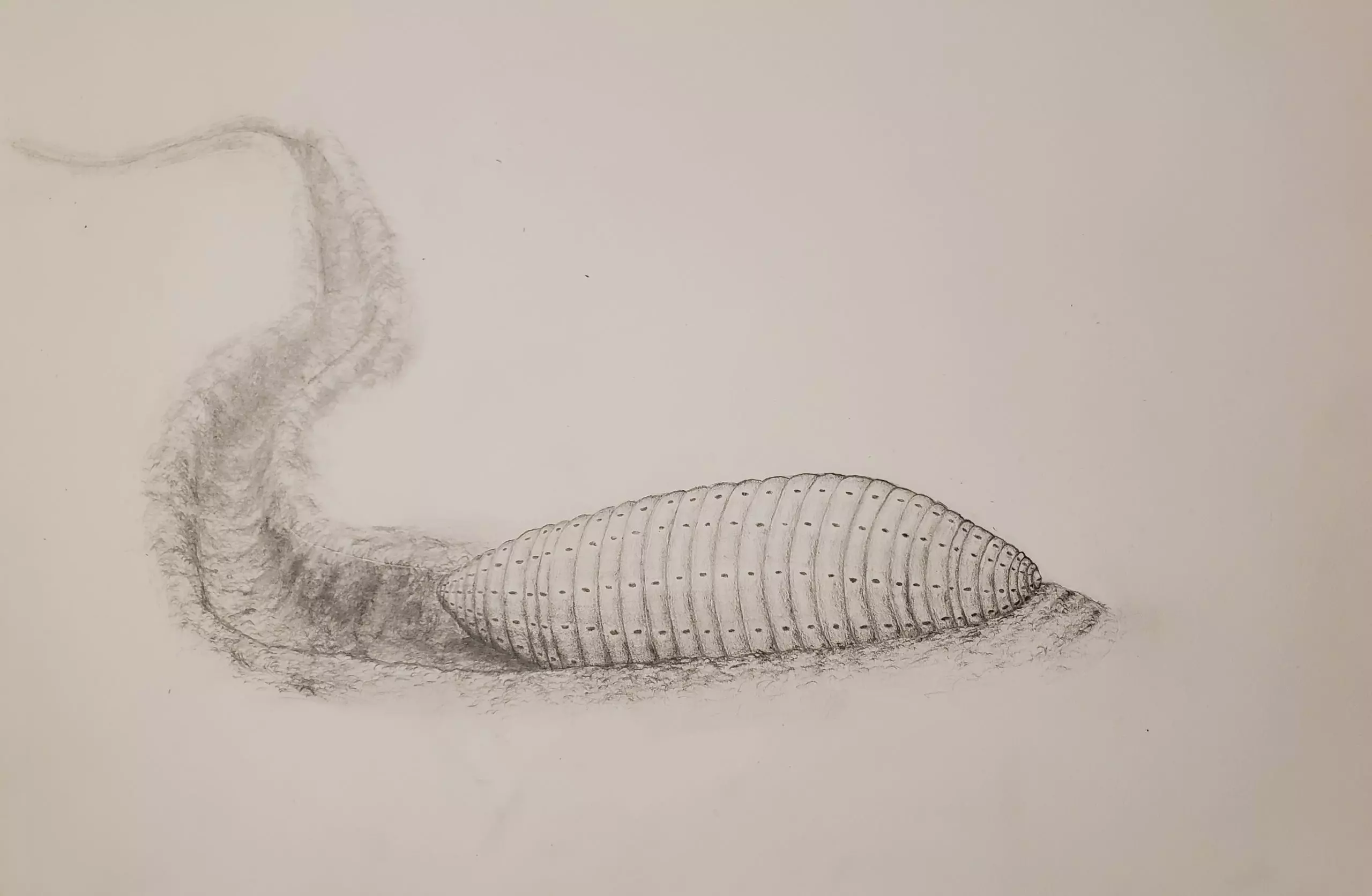An international team of scientists has recently unearthed a tiny, worm-like creature, dubbed Ikaria wariootia, from the Ediacaran geological system in Australia, one of the lowest fossil-bearing layers. The rice-sized animal exhibits distinct front and back ends and a complete digestive tract with two openings, unusual among Ediacaran organisms.
Paleontologists had previously only found burrows (trace fossils) known as Helminthoidichnites, but a recent paper describes over 100 fossils of I. wariootia itself, detected using cutting-edge laser scanning techniques.1 Many science news websites are hailing the discovery as the “ancestor of all animals.”2 How should creationists respond to all the hype?
The Ediacaran Ecosystem and the Creation Model
The first thing to clarify is that there are other animals found in the same layers as Ikaria. These include surprisingly diverse forms, from the deceptively plant-like Charnia3 to the flat, segmented Dickinsonia4 and the weird, vaguely mollusk-like Kimberella.5
However, Ikaria is unique in being a bilaterian (an animal displaying bilateral symmetry, or matching right and left halves with a definite head and tail). Before this, we weren’t sure if there were any Ediacaran bilaterians, though it was suspected that Kimberella might belong to this group.6
Since most animals, including all vertebrates, are bilaterians, the enthusiasm of many evolutionists is understandable. After all, to them, I. wariootia represents a major advance in animal evolution. Young-earth creationists, however, have a different interpretation of the fossil.
While creation geologists attribute most of the earth’s sedimentary layers to the Global Flood of Noah, many believe that Precambrian strata were actually formed before the Flood.7 The Ediacaran system was probably laid down by slow deposition, much as we see in today’s oceans. Thus, the animals that could not escape and were fossilized were either sessile (attached in one location) or exceedingly small, like Ikaria.
God probably created this organism to inhabit a unique seafloor environment, where it burrowed through the sand in search of food, moving by peristaltic locomotion (using contracting muscles, like an earthworm).
Successful Evolutionary Prediction?
Finding a bilaterian in these layers is not a problem for creationists; in fact, it demonstrates the incredible diversity of the pre-Flood ecosystems, even at the bottom of the fossil record. However, the journal paper claims that this represents a successful evolutionary prediction:
This organism is consistent with predictions based on modern animal phylogenetics that the last ancestor of all bilaterians was simple and small and represents a rare link between the Ediacaran and the subsequent record of animal life.8
In essence, evolutionists believe Ikaria matches the predictions of their classification system, called phylogenetics. This system uses branching lines to show the supposed evolutionary relationships of organisms and groups. However, it relies on the presupposition of evolution and is therefore subjective, influenced by the researchers’ bias.9
But why would evolutionists predict more “advanced” animals in lower layers? The answer lies in one of the most baffling enigmas for evolutionists, the so-called “Cambrian Explosion.”
Namely, in Cambrian layers (which are directly above the Ediacaran), representatives from nearly every animal phyla suddenly appear with no transitional forms.10 To account for this, evolutionists are forced to claim that the ancestors of these animals were already around in the Ediacaran, but we have yet to find them.11
They see I. wariootia as the missing link, the ancestor of all these disparate forms. However, this merely pushes the problem farther back. Now, we are beginning to see incredible diversity even among Ediacaran organisms – just what we would expect if God created them that way from the start.12
What about the claims that I. wariootia is more primitive than later animals? Although the preservation of these tiny animals is amazing, it does not include all the minute details of their anatomy. It is impossible to say how “simple” the organism actually is, nor what its sensory organs were like.
While I. wariootia probably would not have needed extremely sophisticated senses for burrowing in the sand, there is no reason to call this “rudimentary.” Considering the amazing design we observe throughout creation, we would expect intricate, fully functional body systems in Ikaria. Whatever senses it had were certainly quite effective and perfectly suited to its lifestyle.
Even now, evolutionists admit that “in spite of its relatively simple shape, Ikaria wariootia was complex compared to other fossils from this period.”13 Evolutionists have a record of calling an organism “simple,” only to find new complexities they would never have expected,14 and Ikaria will likely be no different.
Of course, there is no way for evolutionists to prove that I. wariootia was the ancestor of all bilaterians (and creationists would contend that it was not), so even if it was less complex than some other animals, it still would not support the evolutionary narrative.
God may have created some organisms to be more sophisticated than others, but His works are always “very good” (Genesis 1:31).
Footnotes
1 Evans et al. 2020. “Discovery of the oldest bilaterian from the Ediacaran of South Australia.” Proceedings of the National Academy of Sciences of the United States of America. March 23, 2020. DOI: https://doi.org/10.1073/pnas.2001045117.
2 Ober, Holly. 2020. “Ancestor of all animals identified in Australian fossils.” The University of California Riverside. March 23, 2020. https://news.ucr.edu/articles/2020/03/23/ancestor-all-animals-identified-australian-fossils.
3 “Charnia.” Wikipedia. Accessed May 7, 2020. https://en.wikipedia.org/wiki/Charnia.
4 “Dickinsonia.” Wikipedia. Accessed May 7, 2020. https://en.wikipedia.org/wiki/Dickinsonia.
5 “Kimberella.” Wikipedia. Accessed May 7, 2020. https://en.wikipedia.org/wiki/Kimberella.
6 Fedonkin, Mikhail A. 1997. “The Late Precambrian fossil Kimberella is a mollusk-like bilaterian organism.” Nature. August 28, 1997. https://www.nature.com/articles/42242.
7 Doran, Neal, “Mystery of the First Animals.” Answers in Genesis. April 1, 2015. https://answersingenesis.org/fossils/fossil-record/mystery-first-animals/.
8 Evans et. al. 2020.
9 Sanders, Harry F. III. 2019. “How Should Christians View Biological Classification?” Answers in Genesis. January 22, 2019. .https://answersingenesis.org/theory-of-evolution/how-should-christians-view-biological-classification/.
10 Creationists usually place the beginning of the Flood somewhere in the Lower Cambrian. It makes sense that, with the increased turbulence and deposition that took place as the Flood set in, we would start to see larger and more exquisitely preserved fossils. See Mitchell, Elizabeth. 2015. “Cambrian Explosion or Creation Week—Key to Vertebrate Success?” Answers in Genesis. March 12, 2015. https://answersingenesis.org/theory-of-evolution/evolution-timeline/cambrian-explosion-or-creation-week-key-to-vertebrate-success/.
11 Mitchell, Elizabeth. 2011. “Researchers Devise Alternate Theory for Cambrian Explosion.” Answers in Genesis. December 3, 2011. https://answersingenesis.org/fossils/fossil-record/researchers-devise-alternate-theory-cambrian-explosion/.
12 Another example is the tubular Funisia dorothea, which had complex reproductive mechanisms. “Early Evolutionary Ecosystems Considered Complex.” March 29, 2008. Answers in Genesis. https://answersingenesis.org/fossils/fossil-record/early-evolutionary-ecosystems-considered-complex/.
13 Sci-News. 2020. “Oldest Bilaterian Fossil Found in Australia.” March 24, 2020. http://www.sci-news.com/paleontology/ikaria-wariootia-08254.html.
14 Answers in Genesis. 2009. “Simple Is as Simple Does.” December 5, 2009. https://answersingenesis.org/biology/microbiology/simple-is-as-simple-does/.








“…there are other animals found in the same layers as Ikaria.” They won’t tell that part of the story, will they! I. wariootia seems awfully complex for such a “primitive ancestor”! Great way to expose the fallacies! Thanks, William
Thanks for the encouragement! The journal paper itself doesn’t claim that I. wariootia is the first animal, but several science news articles have that in the headline (see ref. 2). It just sounds more sensational to say they’ve discovered “the first animal” than “the first bilaterian”!